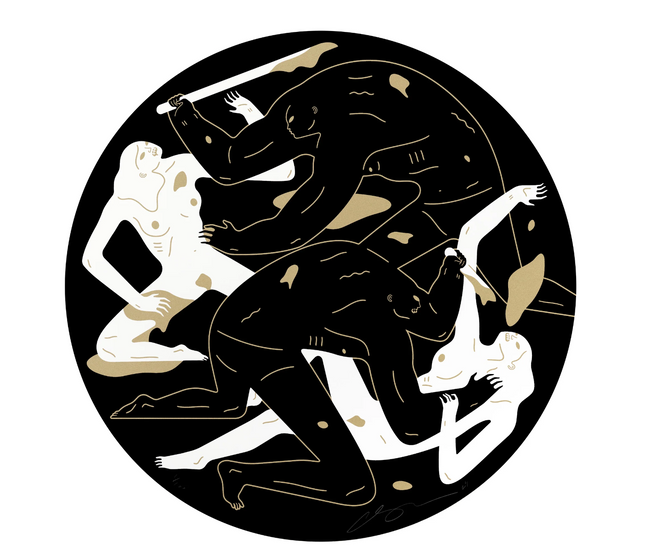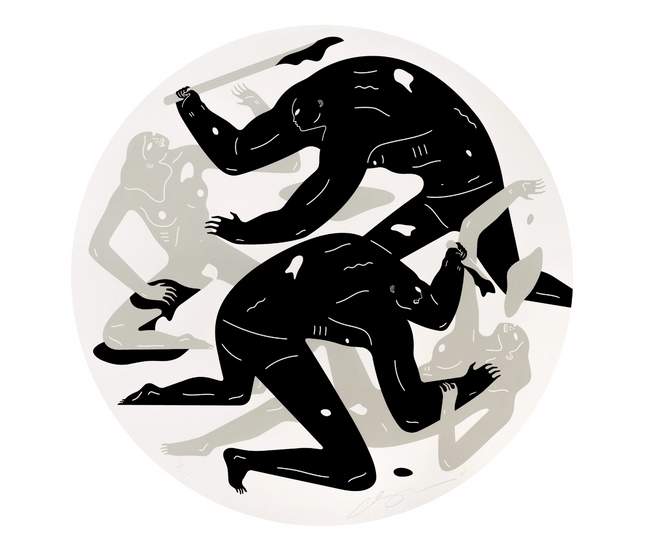
Stabbing & Backstabbing

Cleon Peterson Revolution Is a Mother Who Eats Its Children Black Tondo Silkscreen Print by Cleon Peterson
Revolution Is a Mother Who Eats Its Children Black Tondo Silkscreen Print by Cleon Peterson on Hand Deckled Circle Cut 290gsm Coventry Rag Fine Art Paper Limited Edition Artwork. 2024 Signed & Numbered Cleon Peterson Limited Edition of 100 Artwork Size 24x24 Circle Cut Silkscreen Print. Cleon Peterson's Tondo: A Visceral Exploration of Revolution Cleon Peterson's "Revolution Is a Mother Who Eats Its Children Black Tondo" captures the essence of revolution — its transformative fury and cannibalistic backlash. This 2024 limited edition silkscreen print is a stark embodiment of the cyclic violence inherent in societal upheaval. With his signature high-contrast aesthetic, Peterson compels contemplation of the tumult that accompanies systemic change. Artistic Merits of Peterson's Black Tondo Limited to a series of 100, each piece is meticulously signed and numbered, accentuating the exclusivity of this thought-provoking artwork. The tondo — a circular artwork — measures 24x24 inches, a format that historically suggests wholeness and infinity but represents the never-ending loop of revolutionary fervor in Peterson's hands. The hand-deckled edges of the circle cut 290gsm Coventry Rag fine art paper enhance the tactile quality of the piece, adding to its visceral impact. The choice of the circle is deliberate, disrupting the traditional rectangular canvas to create a more immersive and contemplative experience. This shape allows the violence within to spill out in all directions, mirroring the all-consuming nature of the theme. Peterson's work does not simply hang on a wall; it confronts and envelops the viewer in its narrative. Cultural Commentary through Peterson's Silkscreen In "Revolution Is a Mother Who Eats Its Children Black Tondo," Peterson lays bare the paradoxes of revolt. His use of black — associated with the unknown and often with death — serves as a void into which the figures emerge and are consumed. The artwork is an allegory of the cyclical nature of history, where each act of uprising carries the seeds of its destruction within it. The stark black-and-white hues strip the scene of any romanticism, exposing the raw power struggle. It speaks to the heart of street pop art and graffiti artwork, which often deal in objective truths and lay claim to public spaces as forums for dialogue. Peterson's work takes this further, encapsulating the raw, uncensored voice of the street in a fine art context. The "Revolution Is a Mother Who Eats Its Children Black Tondo" is a poignant reminder of the perpetual dance between order and chaos. It is a piece that encapsulates the essence of Cleon Peterson's approach to street pop art, rendering visible the often uncomfortable realities that underpin human societies. Through his work, Peterson challenges the viewer, compelling a deeper engagement with the undercurrents of cultural and political change.
$1,750.00

Cleon Peterson Revolution Is a Mother Who Eats Its Children Bone Tondo Silkscreen Print by Cleon Peterson
Revolution Is a Mother Who Eats Its Children Bone Tondo Silkscreen Print by Cleon Peterson on Hand Deckled Circle Cut 290gsm Coventry Rag Fine Art Paper Limited Edition Artwork. 2024 Signed & Numbered Cleon Peterson Limited Edition of 100 Artwork Size 24x24 Circle Cut Silkscreen Print. Exploring the Circular Narrative: Cleon Peterson's 'Revolution Is a Mother' "Revolution Is a Mother Who Eats Its Children Bone Tondo," a silkscreen print by Cleon Peterson, encapsulates a poignant message through its unique circular format. The 2024 limited edition, with only 100 signed and numbered prints, dramatically portrays the revolution's cyclic and often self-destructive nature. This artwork, sized at 24x24 inches, is meticulously crafted on hand-deckled circle cut 290gsm Coventry Rag fine art paper, highlighting the contrast between the piece's delicate presentation and its powerful content. Symbolism in Cleon Peterson's Tondo The tondo, a round piece of art, has a rich history dating back to the Renaissance and is often used to symbolize perfection or the divine. Peterson's adaptation of this format into street pop art and graffiti artwork is an inventive means of capturing the perpetual motion of conflict and societal upheaval. The circular frame compels the viewer's eye to move continuously around the image, echoing the cyclical and repetitive nature of the struggles depicted within. While bearing the starkness of Peterson's characteristic black-and-white palette, the print gains a new dimension through its shape, emphasizing the never-ending cycle of revolution and its consequences. The figures within the tondo engage in acts of violence and dominance, with no clear beginning or end, a poignant metaphor for the often unending turmoil of societal change. The Cultural Resonance of Peterson's Work Cleon Peterson's work stands at the crossroads of cultural reflection and artistic expression. "Revolution Is a Mother Who Eats Its Children Bone Tondo" is an artistic creation and a commentary on the nature of social movements and the recurring patterns of history. Peterson confronts the viewer with the paradox of revolution: it is both necessary for evolution and destructive by nature. This tondo silkscreen print contributes to the ongoing dialogue about the role of street pop art in modern discourse. Much like the street artists and graffiti artists before him, Peterson utilizes public forms of expression to comment on private pains and societal dilemmas. The limited edition nature of this work, along with the artist's renown, ensures that this piece will hold its place in contemporary art conversation for years to come. Cleon Peterson's "Revolution Is a Mother Who Eats Its Children Bone Tondo" is a compelling portrayal of the perpetual nature of social upheaval. It serves as a stark reminder of revolution's transformative yet often destructive power. This limited edition silkscreen print encapsulates the essence of street pop art and graffiti artwork, melding historical, artistic formats with contemporary themes to provoke thought, encourage reflection, and challenge the viewer's perspective on the cycles of change.
$1,750.00



